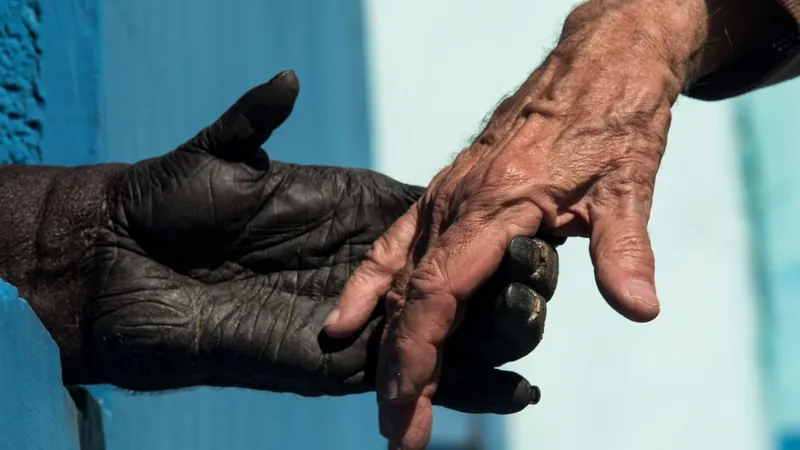
Could Lucy and Early Hominins Have Been Tool Makers Over 3 Million Years Ago? The Surprising Evidence!
2024-11-12
Author: Nur
Introduction
Recent research suggests that our ancient ancestor Lucy, along with her fellow australopithecines, might have been utilizing tools over 3 million years ago, challenging long-held beliefs about the timeline of tool development in human evolution. This groundbreaking study highlights the potential for tool use long before the emergence of the Homo genus.
Research Findings
According to Fotios Alexandros Karakostis, a paleoanthropologist from the University of Tübingen, the team investigated the muscle attachment sites on hand bones from three australopithecine species. The findings reflect that their hand structures could have supported the fine motor skills necessary for manipulating tools. “While we can't claim definitively that they crafted stone tools, our analysis suggests their hands were used in ways aligned with tool manipulation," Karakostis stated.
Published Study
Published in the November edition of the Journal of Human Evolution, this research meticulously compared the hand bones of australopithecines to those of apes and modern humans. The mid-evolutionary stance of australopithecines indicates they possess traits of both ancestral apes and more modern humans, making them an intriguing subject of study.
Muscle Adaptations
Key aspects of the study included muscle entheses, which are specific sites where muscles attach to bones. These sites change in response to habitual use, allowing researchers to reconstruct early hominin behaviors based on their physical adaptations. "Understanding these adaptations provides deeper insights into the daily lives and manipulative capabilities of our ancestors," Karakostis elaborated.
Manipulation Capacity
The research revealed that all three australopithecine species had the capacity for object manipulation, although the more recent Australopithecus sediba showcased a hand structure closer to that of modern humans compared to its older relatives, such as A. africanus and A. afarensis.
Comparative Anatomy
Interestingly, while contemporary apes exhibit some gripping ability, their anatomical structure limits them. In contrast, Homo sapiens possess unique hand muscles that are crucial for precise movements like pinching and gripping. This adaptability not only enabled hominins to manipulate objects effectively but also facilitated significant cultural and technological evolutions.
Study Co-Authors Insight
Jana Kunze, a study co-author, emphasized that features like the first dorsal interosseus muscle between the thumb and index finger were vital for early tool manipulation. The role of the pinky finger, noted in the study, was also essential for daily tasks, suggesting that early hominins relied on these adaptations for activities such as tool handling or food preparation.
Implications for Australopithecus afarensis
The implications of these findings raise critical questions about Australopithecus afarensis – the species to which Lucy belongs. Past theories deemed early hominins incapable of tool-making. However, with the discovery of tools over 3 million years old at Lomekwi in Kenya, experts are now re-examining this narrative, considering the role of A. afarensis in stone tool creation.
Conclusion
While these findings are compelling, they fall short of confirming that A. afarensis or A. sediba specifically crafted tools. Nonetheless, Karakostis underscores that their hand morphology indicates they were adept at humanlike grasping and skilled manipulation.
Expert Commentary
Tracy Kivell, from the Max Planck Institute for Evolutionary Anthropology, who was not involved in the study, lauded the innovative muscle attachment research. “Each australopith seems to have interacted with their environment in unique ways, reflecting their tool usage and climbing capabilities,” Kivell remarked. This research opens new avenues for understanding the evolution of our species and the significant cultural adaptations that came with it.


 Brasil (PT)
Brasil (PT)
 Canada (EN)
Canada (EN)
 Chile (ES)
Chile (ES)
 España (ES)
España (ES)
 France (FR)
France (FR)
 Hong Kong (EN)
Hong Kong (EN)
 Italia (IT)
Italia (IT)
 日本 (JA)
日本 (JA)
 Magyarország (HU)
Magyarország (HU)
 Norge (NO)
Norge (NO)
 Polska (PL)
Polska (PL)
 Schweiz (DE)
Schweiz (DE)
 Singapore (EN)
Singapore (EN)
 Sverige (SV)
Sverige (SV)
 Suomi (FI)
Suomi (FI)
 Türkiye (TR)
Türkiye (TR)